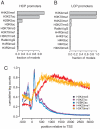Histone modification levels are predictive for gene expression
- PMID: 20133639
- PMCID: PMC2814872
- DOI: 10.1073/pnas.0909344107
Histone modification levels are predictive for gene expression
Abstract
Histones are frequently decorated with covalent modifications. These histone modifications are thought to be involved in various chromatin-dependent processes including transcription. To elucidate the relationship between histone modifications and transcription, we derived quantitative models to predict the expression level of genes from histone modification levels. We found that histone modification levels and gene expression are very well correlated. Moreover, we show that only a small number of histone modifications are necessary to accurately predict gene expression. We show that different sets of histone modifications are necessary to predict gene expression driven by high CpG content promoters (HCPs) or low CpG content promoters (LCPs). Quantitative models involving H3K4me3 and H3K79me1 are the most predictive of the expression levels in LCPs, whereas HCPs require H3K27ac and H4K20me1. Finally, we show that the connections between histone modifications and gene expression seem to be general, as we were able to predict gene expression levels of one cell type using a model trained on another one.
Conflict of interest statement
The authors declare no conflict of interest.
Figures

 corresponds to a vector of length L (the number of promoters), where the components are the transformed levels of a histone modification i (
corresponds to a vector of length L (the number of promoters), where the components are the transformed levels of a histone modification i ( , with Ni representing the number of tags in each promoter), a is the y intercept , and the bi to the slope associated with
, with Ni representing the number of tags in each promoter), a is the y intercept , and the bi to the slope associated with  . y denotes a vector of length L whose components are the expression values. In the one-modification models, i can be any of the 39 modifications or two control IgG antibodies. In the two-modifications models, i and j are chosen to cover all combinations of two modifications without repetition. In the three-modifications models, i, j, and k are chosen to cover all combinations of three modifications without repetition. The full model incorporates all 41 variables.
. y denotes a vector of length L whose components are the expression values. In the one-modification models, i can be any of the 39 modifications or two control IgG antibodies. In the two-modifications models, i and j are chosen to cover all combinations of two modifications without repetition. In the three-modifications models, i, j, and k are chosen to cover all combinations of three modifications without repetition. The full model incorporates all 41 variables.

Similar articles
-
Human genes with CpG island promoters have a distinct transcription-associated chromatin organization.Genome Biol. 2012 Nov 27;13(11):R110. doi: 10.1186/gb-2012-13-11-r110. Genome Biol. 2012. PMID: 23186133 Free PMC article.
-
CpG islands under selective pressure are enriched with H3K4me3, H3K27ac and H3K36me3 histone modifications.BMC Evol Biol. 2013 Jul 10;13:145. doi: 10.1186/1471-2148-13-145. BMC Evol Biol. 2013. PMID: 23837650 Free PMC article.
-
Histone modification profiles are predictive for tissue/cell-type specific expression of both protein-coding and microRNA genes.BMC Bioinformatics. 2011 May 14;12:155. doi: 10.1186/1471-2105-12-155. BMC Bioinformatics. 2011. PMID: 21569556 Free PMC article.
-
Understanding the interplay between CpG island-associated gene promoters and H3K4 methylation.Biochim Biophys Acta Gene Regul Mech. 2020 Aug;1863(8):194567. doi: 10.1016/j.bbagrm.2020.194567. Epub 2020 Apr 29. Biochim Biophys Acta Gene Regul Mech. 2020. PMID: 32360393 Free PMC article. Review.
-
Mechanisms of transcriptional repression by histone lysine methylation.Int J Dev Biol. 2009;53(2-3):335-54. doi: 10.1387/ijdb.082717ph. Int J Dev Biol. 2009. PMID: 19412890 Review.
Cited by
-
A global genome segmentation method for exploration of epigenetic patterns.PLoS One. 2012;7(10):e46811. doi: 10.1371/journal.pone.0046811. Epub 2012 Oct 12. PLoS One. 2012. PMID: 23077526 Free PMC article.
-
Cell type-specific genomics of Drosophila neurons.Nucleic Acids Res. 2012 Oct;40(19):9691-704. doi: 10.1093/nar/gks671. Epub 2012 Aug 1. Nucleic Acids Res. 2012. PMID: 22855560 Free PMC article.
-
On the immortality of television sets: "function" in the human genome according to the evolution-free gospel of ENCODE.Genome Biol Evol. 2013;5(3):578-90. doi: 10.1093/gbe/evt028. Genome Biol Evol. 2013. PMID: 23431001 Free PMC article.
-
GENet: A Graph-Based Model Leveraging Histone Marks and Transcription Factors for Enhanced Gene Expression Prediction.Genes (Basel). 2024 Jul 18;15(7):938. doi: 10.3390/genes15070938. Genes (Basel). 2024. PMID: 39062717 Free PMC article.
-
CatLearning: highly accurate gene expression prediction from histone mark.Brief Bioinform. 2024 Jul 25;25(5):bbae373. doi: 10.1093/bib/bbae373. Brief Bioinform. 2024. PMID: 39073831 Free PMC article.
References
-
- Davey CA, Sargent DF, Luger K, Maeder AW, Richmond TJ. Solvent mediated interactions in the structure of the nucleosome core particle at 1.9 a resolution. J Mol Biol. 2002;319(5):1097–1113. - PubMed
-
- Kornberg RD. Chromatin structure: A repeating unit of histones and DNA. Science. 1974;184(4139):868–871. - PubMed
-
- Kornberg RD, Thomas JO. Chromatin structure; oligomers of the histones. Science. 1974;184(4139):865–868. - PubMed
-
- Luger K, Mader AW, Richmond RK, Sargent DF, Richmond TJ. Crystal structure of the nucleosome core particle at 2.8 A resolution. Nature. 1997;389(6648):251–260. - PubMed
Publication types
MeSH terms
Substances
LinkOut - more resources
Full Text Sources
Other Literature Sources

